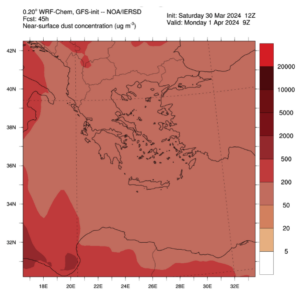The African dust transport phenomenon returns from today, albeit in lower concentrations than in previous days, while temperatures will rise slightly and remain at unseasonably high levels.
A video of the new wave of African dust that will hit the country was uploaded by Klearchos Marousakis on his personal Facebook account.
“The satellite images are impressive in terms of capturing the new wave of African dust that is already starting to affect our country,” the OPEN meteorologist wrote in a video of NASA satellite photos of African dust from space.
The African dust will continue to transport until Tuesday, when it will gradually diminish in the east.
See in the meteo.gr graphic the evolution of the dust particle concentration here.
As for the temperature, it will rise slightly and will be high for the season. It will reach 25 to 27 degrees Celsius in the islands and coastal areas, 27 to 29 degrees Celsius in the rest of the country and locally 30 to 31 degrees Celsius in the eastern mainland.
On Tuesday, although the temperature will drop slightly in the northwest, where it will reach 21 to 23 degrees Celsius, it will remain high for the season and will reach 27 to 30 degrees Celsius locally in the eastern mainland and Crete.

New episodes of African dust until the end of May
New episodes of African dust accumulation are expected until the end of May, according to Professor Andreas Kazantzidis, chairman of the Physics Department of the University of Patras and Director of the Laboratory of Atmospheric Physics, speaking to the Athens-Macedonian News Agency.
As he explains, “during spring, i.e. from March to May, atmospheric circulation helps to have an invasion of desert gas masses over the eastern Mediterranean”.
Regarding the latest invasion of African dust, Andreas Kazantzides told AP-ME that “there was a three-day period where African dust concentration values were significantly high, and the worst day was last Wednesday.
It is indicative of the fact that in the region the average daily value of PM10 particulate matter concentration was 65 μg/m³”.
“This value”, he added, “is quite significant, considering that the World Health Organisation says that the 50 µg/m³ limit should not be exceeded more than 35 times a year”.
“Essentially”, he continued, “it was one of the significant episodes of African dust concentration, but it is not an extreme”, since, he reiterated, “during the spring we have an invasion of African dust”.
“Besides”, as Andreas Kazantzides stressed to AP – MPE, “the closer a region is to Africa, the more difficult the situation with African dust, which is exactly why the island of Crete faced the biggest problems, due to the high dust concentration values”.
Speaking about particle concentrations, he said that “the characteristic we have is that most of them are not on the ground, but some kilometres higher, because they travel a little higher in the atmosphere, since they come from far away.”
Citing satellite imagery, he said that “we see the dust layer, but that does not mean that it is on the ground, since only a percentage reaches it, which we can see and understand in the visibility anyway.”
Life need not ever end – Depressing established scientific idea may be wrong
Regarding the suspended particles of dust, Andreas Kazantzidis told the APE – MPE “that they are large and not small like the pollution we have in the winter period, such as from the burning of fireplaces.”
“So,” he continued, “in our network that shows the values of small particles in real time, surprisingly nothing was seen, while in reality in large particles we had very high values.”
At the same time, the professor stressed that “particulate matter in general is probably the most difficult phenomenon for us and the most difficult factor when one wants to see the role of atmospheric science, whether talking about forecasting the weather the next day, or even talking about climate change… The particles are all moving westward, and there’s a lot of work showing how much they affect fertility in the Amazonian soils that are on the other side of the Atlantic.”
“It’s a phenomenon,” he stressed, “that goes beyond the boundaries of one state, obviously having an impact on people’s health.”
Ask me anything
Explore related questions





